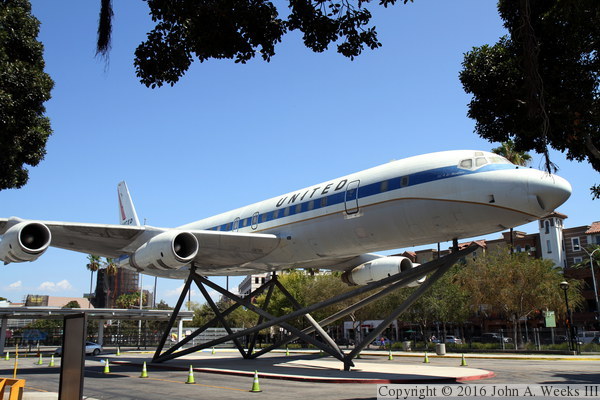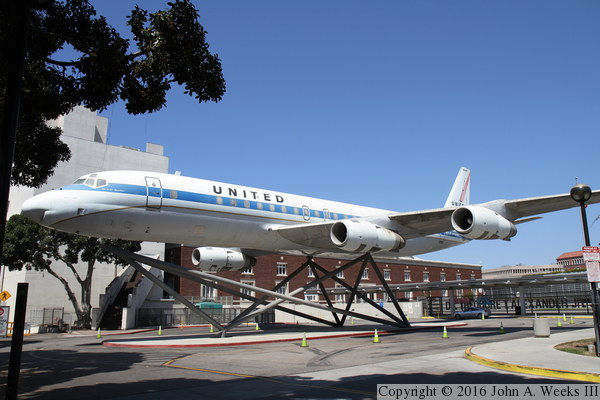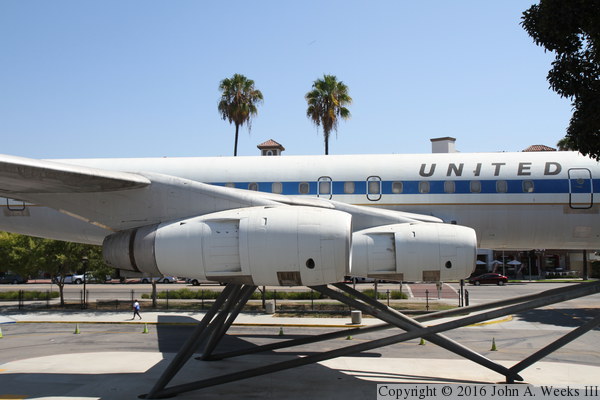
|
John A. Weeks III
Friday, January 9, 2026, 12:10:40 AM CST |
|||
| Home | Photo Tours | Rail Fan | 12 Easy Steps |
| Aviation | Spacecraft | Highways & Bridges | About The Author |

|
|
|||||||||||||||||
Douglas DC-8September 8, 2015
This is a Douglas DC-8 commercial passenger jet on display at the California
Science Center in Los Angeles, California. The DC-8 was an early passenger
jet developed by Douglas Aircraft. It is less well known than the Boeing 707,
and often mistaken for the 707. You can identify a DC-8 by the two air inlets
located just under the nose of the aircraft. Boeing got a big head start in
developing a passenger jet when it was selected to build a jet refueling
airplane for the US Air Force. Douglas was forced to develop the DC-8 using
their own funds. Over 1,000 707's and related variants were produced for
commercial use, while only 556 DC-8's were built. However, in recent years,
the 707 is all but extinct with only a few dozen still in service, yet
hundreds of DC-8's soldier on as cargo carriers.

A DC-8 was involved in an unusual test flight on August 21, 1961. First, the
aircraft climbed high over Edwards Air Force Base obtaining an altitude of
52,090 feet, which was an altitude record for a passenger aircraft. From there,
it was put into a shallow dive. After descending 11,000 feet, it broke the
sound barrier becoming the first passenger aircraft to go supersonic. It
hit a speed of Mach 1.012. The pilot then attempted to pull out of the dive,
but experienced difficulty when the plane did not pull up when he pulled back on
the controls. The shock wave caused the control surfaces to react
differently. In some cases, this can cause flight controls to change behavior
to the point where they do just the opposite of what is expected at subsonic
speeds. After a bit of troubleshooting, the crew added extra trim to the
aircraft, and it responded by pulling out of the dive and showing down below
the speed of sound. While the Concorde gets all the press for flying twice
the speed of sound, both the DC-8 and Soviet Tu-144 few supersonic before the
Concorde.

This DC-8 was delivered to United Airlines in 1966. It was placed in storage
in Las Vegas in 1980 and later retired. In that time, it flew more than
18-million miles carrying over 1-million passengers. It was donated to the
California Science Center in June, 1984. It was flown to Los Angeles. There
the wings were removed and it was towed through city streets to Exposition
Park, then reassembled at the museum. It was on display at ground level until
it was repainted and mounted on a pedestal in 2002.

The California Science Center has a nice collection of historic aircraft and
space hardware including a Mercury and Gemini capsules. The museum made a bid
to host a retired space shuttle when the program was canceled, and they were
were awarded OV-105 Endeavour. Endeavour arrived at the museum in October,
2012, and went on display in a temporary building. The museum is in the
process of developing a spectacular new air and space gallery that will
feature the space shuttle stacked vertically with an external tank in
launch configuration, as well as display space for its entire collection of
aircraft and other space hardware. Construction was just starting in late
2015 when I visited the site.
|
|
|
Authored by John A. Weeks III, Copyright © 1996—2016, all rights reserved. For further information, contact: john@johnweeks.com
|